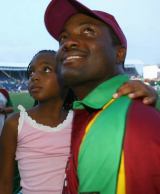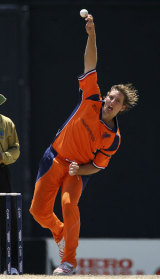The Departed
Cricinfo puts together a retirement XI after the 2007 World Cup
|
|

|
Arguably the greatest modern-day batsman, few accomplishments evaded Brian Lara's grasp over a 17-year career. He tops many lists; Test and first-class cricket's highest scores, highest run-getter in Test cricket. He is also a close second in many others; joint second-highest century-maker and second-highest number of Test catches as an outfielder. He sparkled magnificently in winning efforts, sparkled equally magnificently in losing ones and led his country thrice, mostly problematically. In fact, success as captain and success at the World Cup are about the only achievements missing from an outrageously accomplished career. Fitting then that both came together in such bitter disharmony at home in 2007, Lara taking strange decisions, out of form and unable to unite or inspire his teammates. A way to go it wasn't.
He burst onto the international scene during the 1992 World Cup and whimpered out tearfully in the 2007 edition, totaling 74 runs (an improvement at least on his 19 runs in 2003). In between he was Pakistan's man of steel; their most successful ODI batsman and possibly overall, he finished third-highest ODI run-scorer ever and with the most fifties (83), all made with a lumbering mix of cunning and aggression. His captaincy and running was questioned, but holding a bat, he galloped effortlessly to numerous victories (and occasionally towards mocking spectators). Despite the bulk, he was a safer fielder and catcher than many gave him credit for but he'll remember his final exit for reasons other than his batting.
To everyone's surprise, the frugal left-arm medium pace of Ian Bradshaw was only witnessed in three World Cup 2007 matches. Not enough artillery in the bag for a five-day match, Bradshaw was confined to the shorter version of the game even with a first-class century and over 150 wickets to his name. His greatest moment for West Indies, however, came with the bat in the 2004 Champions Trophy final when he added 71 for the ninth wicket with Courtney Browne and steered his team to glory. The emergence of Jerome Taylor and success of Darren Powell, and some questionable team selection, meant a sorry swansong for Bradshaw, who finished an unassuming career of 62 ODIs and 78 wickets.
He had ceased to be India's first-choice pyjama-wearing spinner since a shoulder injury in October 2000 and only sneaked into the World Cup squad late, to minimal effect but Kumble was an ODI threat for much of his career. He relied for much of that period mostly on bounce and trajectory, an immensely difficult bowler to get away at any stage and a lethal faster ball to boot. At the 1996 World Cup, he ended the leading wicket-taker, ahead of Shane Warne and Muttiah Muralitharan. The injury lessened his ODI effectiveness, while enhancing his Test threat (the flipper went, as did the pace and zip to be replaced by loop and a googly) and he only played 63 ODIs after the injury. He finished fittingly, a wicket with his last ball against Bermuda, and still managed to end India's highest-ever ODI wicket-taker.
|
|

|
Has there been a greater fast bowler ever? Accuracy, bounce, zip, an action on repeat and a brain; there hasn't been a more successful one, in terms of Test wickets, and only three are ahead of his ODI haul of 381. There hasn't been anyone with a better sense of occasion surely; Brian Lara was the 300th Test victim, the middle of a hat-trick, he took a wicket with his last ball in Test cricket and ODI cricket in Australia, ended correctly predicting a 5-0 win over England and bowed out of international cricket with a World Cup win and a player of the tournament award in the bag. Along with Shane Warne, Australia's biggest hole to fill.
His World Cup appearance at the age of 40 was not only 12 years after his last outing against major international opposition, but was also for a different nation altogether. He only played five, largely unsuccessful Tests for the West Indies in the early 90s, but it was probably on the back of his 63 ODIs for them (at a strike rate better than both Ambrose and Marshall), and experience of Caribbean conditions, that he was surprisingly included in the Canadian squad for the World Cup. Cummins added a brace to his 89 ODI wickets in three average performances, the days when crowds boycotted a Test in Barbados because he wasn't selected ("No Cummins, no goings" they protested), long gone. To no one's surprise, he bid adieu immediately after.
A quiet retirement from a quiet cricketer, Arnold's graft and accumulating style suited him far more as a lower-middle order ODI batsman than as the Test opener he started his career as. His part-time off-breaks enhance the impression that he was a prototype but lesser version of Tillakaratne Dilshan, but Arnold was a vital cog in Sri Lanka's side after their World Cup triumph in 1996. Youth almost did for him after the 2003 World Cup, but a cool head under pressure never goes out of fashion, and so he was called back four years later. In his own quiet way, he helped his side to the final, though perhaps his two-ball stay was too quiet a way to say goodbye.
A middle-order batsman and amiable man, van Troost's most memorable act in cricket was his last one. With five runs and a wicket to show from his opening two matches of the World Cup 2007, van Troost, captain and selector of the Netherlands team, not only dropped himself, like Mike Denness, for the final match of the tournament, but also bade farewell to international cricket. His left-arm medium pace was more a support mechanism than attack, and van Troost claimed four wickets in his four-and-a-half year career in which he captained the side for four.
Following his solitary outing, and a single wicket in the World Cup, Anthony Ireland, like many around him, turned his back on the national side and headed off to play county cricket. The 22-year-old seam bowler made his debut after the 2004 rebellion in which several national players were axed. He represented Zimbabwe 26 times in ODIs and went on to claim 38 wickets but owed appearance fee and bonuses from the World Cup, Ireland, 22, got fed up of the political stranglehold of the cricket administration and signed a two-year deal with Gloucestershire.
|
|

|
van Bunge made headlines for the right reasons in the 2003 World Cup, with 62 against India and three wickets against England. He made headlines again four years later, though for the wrong reasons, his legspin tonked for a record six sixes in an over by Herschelle Gibbs. His batting was the stronger suit, as a 38-ball century against Surrey U-19s once suggested but his final figures never bore that out. Among his country's more gifted allrounders, he might end up being remembered as a poster boy for the problems afflicting amateurs in a professional environment; citing an inability to commit enough time to play for his country as well as pursue a full-time job, he announced his unavailability for international cricket after the World Cup, at the grand old age of 24.
Had it not been for Ireland's wonderful campaign, then playing alongside Steve Waugh, Ireland's overseas player in 1998 might have been the highlight of Paul Mooney's career. The medium-pacer only played four ODIs for Ireland but was far more successful in the ICC Trophy, picking up 17 wickets in 13 matches. In the other 80 times he represented Ireland, Mooney claimed over 50 wickets. At 31, he is still young but he has made it clear that a development role helping Ireland cash in on their success is a possibility post-retirement.
Faras Ghani is an editorial assistant at Cricinfo